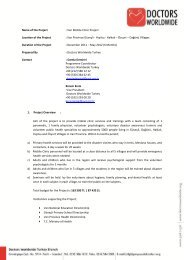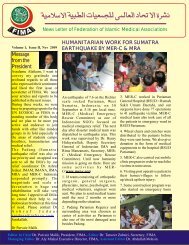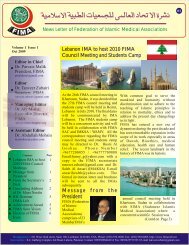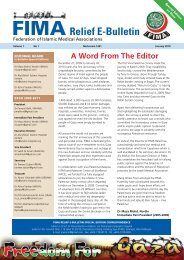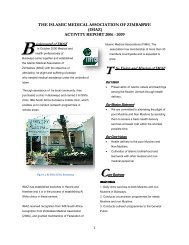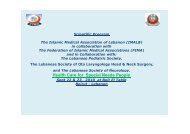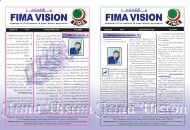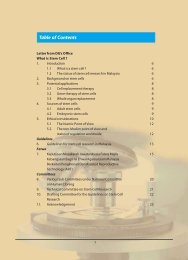FIMA Year Book 2009 - Federation of Islamic Medical Associations
FIMA Year Book 2009 - Federation of Islamic Medical Associations
FIMA Year Book 2009 - Federation of Islamic Medical Associations
You also want an ePaper? Increase the reach of your titles
YUMPU automatically turns print PDFs into web optimized ePapers that Google loves.
Problem Based Learningreviewed the evidence for and againstproblem based learning, (14-16) , and inspite <strong>of</strong> semantic difficulties, differentstudy designs, confounding variables,and different interpretations <strong>of</strong> theevidence, several benefits have beenidentified. The identified benefits <strong>of</strong> PBLcan be summarized as follows:• Promotes deep, rather than surface,learning• Enhances and retains self directedskills• Learning environment is morestimulating• Promotes interaction betweenstudents and staff• Promotes collaboration betweendisciplines—for example, basic andclinical scientists• More enjoyable for students andteachers• Promotes retention <strong>of</strong> knowledge• Improves motivation, (17)Some <strong>of</strong> these benefits may beindistinguishable from those relatedto other curricular innovations.Maudsley, (17) , however, considersproblem based learning to havesurvived unprecedented scrutiny. Aboveadvantages have been demonstratedseveral times , in different studiesconducted in different countrieswith differing systems <strong>of</strong> medicalinstruction, (17) . Several disadvantageshave also been identified includingthe initial costs and human resourcerequired for the start up and maintenance<strong>of</strong> PBL systems, excessive demands onstaff time and efficiency, increased stressdue to higher learning needs on bothstudents and faculty, relatively reducedacquisition <strong>of</strong> knowledge <strong>of</strong> purebasic sciences, and implementationdifficulties when class sizes are large orwhere there is an absolute or relative lack<strong>of</strong> enthusiasm among the implementingmembers <strong>of</strong> faculty and staff for theapproach, (16) . Finucane and colleaguesprovide a balanced consideration <strong>of</strong>the advantages and disadvantages <strong>of</strong>adopting a curriculum for problembased learning, (18) . There is as yet noconcrete and mutually agreed uponevidence that graduates <strong>of</strong> problembased medical instruction programsmake better, worse or exceptionalteachers or practitioners in the longterm.It is easy to gather from abovebackground information that PBL,although a very elegant and attractivephilosophy <strong>of</strong> medical instruction,nonetheless comes at a price; bothliterally and metaphorically speaking.Following is a list <strong>of</strong> pre-requisitesto the institution <strong>of</strong> PBL as the maineducational strategy compiled as aconsensus document in 1993 WorldSummit on <strong>Medical</strong> Education <strong>of</strong>the World <strong>Federation</strong> for <strong>Medical</strong>Education, (19, 20) :• Class size limited to 100 students, (20)• “Small Groups” <strong>of</strong> students with,preferably 6 students per group, (20)• Infrastructure support with tutorialrooms, computers, libraries and skill(21, 22)labs,• Faculty commitment withsubsequent integration <strong>of</strong> medicalcurriculum PRIOR to placing PBL as<strong>FIMA</strong> <strong>Year</strong><strong>Book</strong> <strong>2009</strong>50




